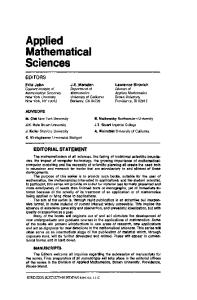The Selberg-Arthur Trace Formula Based on Lectures by James Arthur
This book based on lectures given by James Arthur discusses the trace formula of Selberg and Arthur. The emphasis is laid on Arthur's trace formula for GL(r), with several examples in order to illustrate the basic concepts. The book will be useful and sti
- PDF / 4,840,984 Bytes
- 104 Pages / 468 x 684 pts Page_size
- 59 Downloads / 338 Views
1503
Salahoddin Shokranian
The Selberg-Arthur Trace Formula Based on Lectures by James Arthur
Springer-Verlag Berlin Heidelberg New York London Paris Tokyo Hong Kong Barcelona Budapest
Author Salahoddin Shokranian Departamento de Matematica Universidade de Brasflia 70910 Brasflia-DF, Brasil
Mathematics Subject Classification (1991): 22-XX
ISBN 3-540-55021-6 Springer-Verlag Berlin Heidelberg New York ISBN 0-387-55021-6 Springer-Verlag New York Berlin Heidelberg This work is subject to copyright. All rights are reserved, whether the whole or part of the material is concerned, specifically the rights of translation, reprinting, re-use of illustrations, recitation, broadcasting, reproduction on microfilms or in any other way, and storage in data banks. Duplication of this publication or parts thereof is permitted only under the provisions of the German Copyright Law of September 9, 1965, in its current version, and permission for use must always be obtained from Springer-Verlag. Violations are liable for prosecution under the German Copyright Law. © Springer-Verlag Berlin Heidelberg 1992 Printed in Germany
Typesetting: Camera ready by author Printing and binding: Druckhaus Beltz, HemsbachlBergstr. 46/3140-543210 - Printed on acid-free paper
Introduction Since the appearence of A. Selberg's famous paper in 1956, it gradually became clear that the role of Selberg's trace formula in automorphic forms, number theory, and representation theory is fundamental. Selberg's paper is essentially concerned with the derivation of a trace formula for the regular representation of the group PSL 2 (JR ), and the application of this formula in calculating the trace of the Heeke operators for that group. The importance of Selberg's paper naturally raised the question of how to generalize this trace formula to groups of higher ranks, and how to apply the formula in many problems directly or indirectly related to automorphic forms. Here we shall explain very briefly the attempts which have been made over many years to advance Selberg's theory of the trace formula. Firstly, regarding the generalizations, a basic idea had already been indicated in Selberg's paper itself. This idea was that the Eisenstein series has an important role to play in advancing the theory from P S L 2 to the higher rank groups. One reason for this was the need to characterize the continuous spectrum of the regular representation of a Lie group G into the Hilbert space L 2(f\G), for a discrete subgroup I' of G. Indeed, as a result of Langlands' work on the Eisenstein series, the continuous spectrum .of the spectral decomposition was fully characterized and a major step toward the generalization of Selberg's trace formula was thus taken. On the other hand, the Dufio-Labesse paper in the late sixties, and J. Arthur's work in the early seventies were important, since the former provided thorough rigorous proof through representation theory of the work of Selberg, and the latter took the first steps toward the generalization of the trace formula for the highe
Data Loading...











